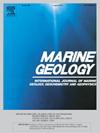泥沙重力流驱动了现代黄河三角洲前缘的形成
IF 2.6
3区 地球科学
Q2 GEOSCIENCES, MULTIDISCIPLINARY
引用次数: 0
摘要
三角洲前缘的快速发展受到泥沙重力流的严重影响,对沿海基础设施构成了重大挑战。准确评估由河流洪水、边坡破坏和波浪活动引发的sgfs对三角洲前缘地貌和沉积模式的长期影响仍然是一项复杂的任务。在三角洲发育的形成阶段,这种复杂性更加突出,在这个阶段,区分不同的SGF触发因素的贡献尤其具有挑战性。为了解决这个问题,我们采用了正演地层模型Sedflux-2D,根据观测值整合了关键输入参数,如初始水深、河流流量、悬沙浓度和波高。利用地震地层学和沉积物岩心粒度数据对模型进行校正,重建了现代黄河三角洲的年代际演化。通过将模拟结果与当前水深和粒度分布进行比较,我们定量评估了波浪能、河流流量和边坡稳定性等主要因素对MHD锋面发展的影响。研究结果表明,在近岸环境向近海环境过渡的过程中,三角洲地层内沉积物粒度分布主要受波浪、河流和崩塌驱动的sgf控制。在次年代际到年代际的时间尺度上,河流洪水产生的超旋流对三角洲泥沙动力学有重要贡献,约占总泥沙量的20%和森林进积的30 - 50%。与此同时,崩塌引起的sgf约占森林沉积物体积损失的25%,影响水深10 m以上的底部发育。这些发现强调了高旋流在形成MHD锋面中的关键作用。该研究将正演模拟与逆沉积记录分析相结合,为量化SGFs对三角洲前缘发育的贡献提供了一个强大的框架。从该方法中获得的全面见解对于delta管理中的明智决策是必不可少的。本文章由计算机程序翻译,如有差异,请以英文原文为准。
Sediment gravity flows drive the buildup of the modern Huanghe (Yellow River) delta front
The rapid development of the delta front is heavily influenced by sediment gravity flows (SGFs), posing significant challenges to coastal infrastructure. Accurately assessing the long-term impacts of SGFs—triggered by river floods, slope failures, and wave activities—on delta front geomorphology and sedimentation patterns remains a complex task. This complexity is heightened during the formative stages of delta development, where distinguishing between the contributions of different SGF triggers is particularly challenging. To address this, we employed the forward stratigraphic model Sedflux-2D, integrating key input parameters, such as initial bathymetry, river discharge, suspended sediment concentration, and wave height, based on observed values. The model was calibrated against seismic stratigraphy and sediment core grain size data to reconstruct the annual-to-decadal evolution of the modern Huanghe Delta (MHD). By comparing the simulated outputs with present-day bathymetry and grain size distributions, we quantitatively evaluated the impacts of SGFs driven by primary factors such as wave energy, river discharge, and slope stability on MHD front development. Our findings reveal that, during the transition from nearshore to offshore environments, sediment grain size distribution within the delta strata is predominantly controlled by SGFs driven by waves, river fed, and collapses. Hyperpycnal flows, generated by river floods, contribute significantly to deltaic sediment dynamics, accounting for approximately 20 % of total sediment volume and 30–50 % of foreset progradation over sub-decadal to decadal timescales. Collapse-induced SGFs, meanwhile, are responsible for approximately 25 % of foreset sediment volume loss, influencing bottomset development beyond 10 m water depth. These findings highlight the critical role of hyperpycnal flows in shaping the MHD front. This study integrates forward simulation with inverse sediment record analysis, providing a robust framework for quantifying the contributions of SGFs to delta front development. The comprehensive insights gained from this approach are essential for informed decision-making in delta management.
求助全文
通过发布文献求助,成功后即可免费获取论文全文。
去求助
来源期刊

Marine Geology
地学-地球科学综合
CiteScore
6.10
自引率
6.90%
发文量
175
审稿时长
21.9 weeks
期刊介绍:
Marine Geology is the premier international journal on marine geological processes in the broadest sense. We seek papers that are comprehensive, interdisciplinary and synthetic that will be lasting contributions to the field. Although most papers are based on regional studies, they must demonstrate new findings of international significance. We accept papers on subjects as diverse as seafloor hydrothermal systems, beach dynamics, early diagenesis, microbiological studies in sediments, palaeoclimate studies and geophysical studies of the seabed. We encourage papers that address emerging new fields, for example the influence of anthropogenic processes on coastal/marine geology and coastal/marine geoarchaeology. We insist that the papers are concerned with the marine realm and that they deal with geology: with rocks, sediments, and physical and chemical processes affecting them. Papers should address scientific hypotheses: highly descriptive data compilations or papers that deal only with marine management and risk assessment should be submitted to other journals. Papers on laboratory or modelling studies must demonstrate direct relevance to marine processes or deposits. The primary criteria for acceptance of papers is that the science is of high quality, novel, significant, and of broad international interest.
 求助内容:
求助内容: 应助结果提醒方式:
应助结果提醒方式:


